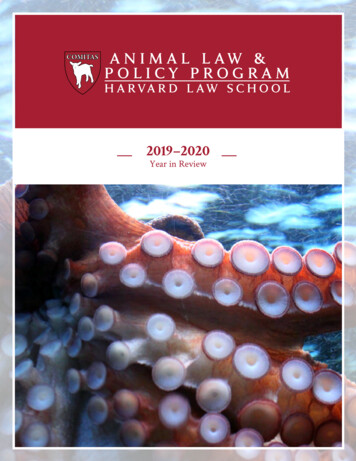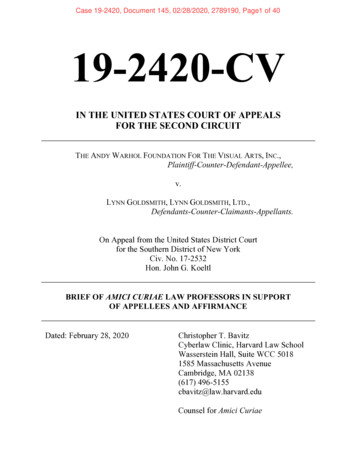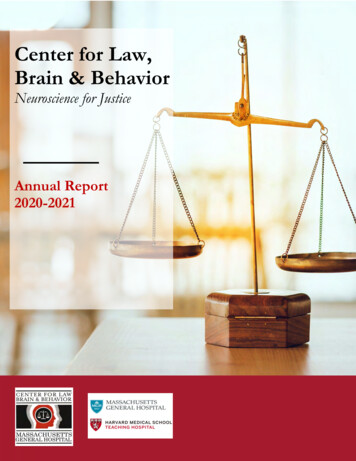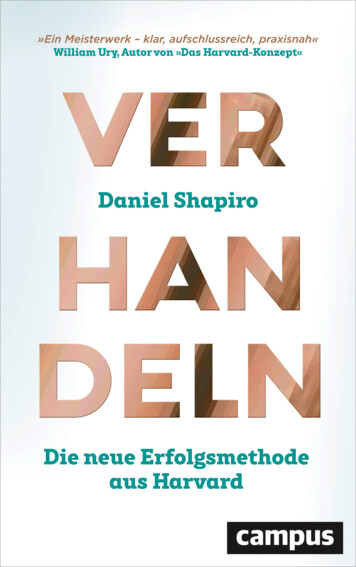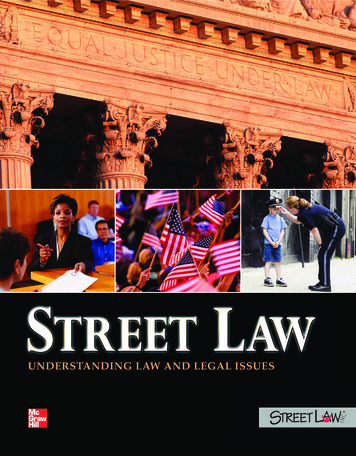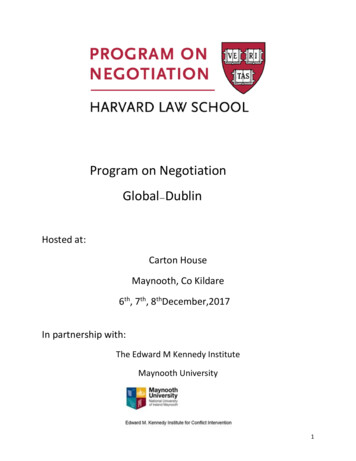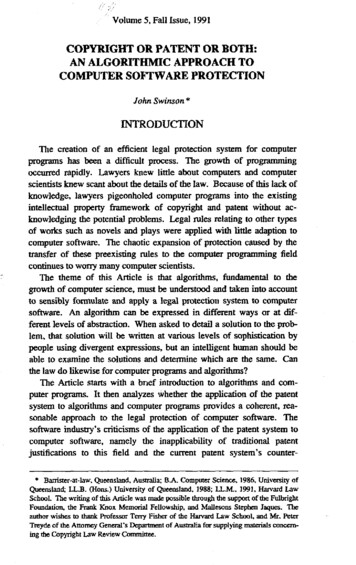
Transcription
Volume 5, Fall Issue, 1991COPYRIGHTO R P A T E N T O R BOTH:AN ALGORITHMICAPPROACH TOCOMPUTERSOFTWAREPROTECTIONJohn Swinson *INTRODUCTIONThe creation of an efficient legal protection system for computerprograms has been a difficult process. The growth of programmingoccurred rapidly. Lawyers knew tittle about computers and computerscientists knew scant about the details of the law. Because of this lack ofknowledge, lawyers pigeonholed computer programs into the existingintellectual property framework of copyright and patent without acknowledging the potential problems. Legal rules relating to other typesof works such as novels and plays were applied with little adaption tocomputer software. The chaotic expansion of protection caused by thetransfer of these preexisting rules to the computer programming fieldcontinues to worry many computer scientists.The theme of this Article is that algorithms, fundamental to thegrowth of computer science, must be understood and taken into accountto sensibly formulate and apply a legal protection system to computersoftware. An algorithm can be expressed in different ways or at different levels of abstraction. When asked to detail a solution to the problem, that solution will be written at various levels of sophistication bypeople using divergent expressions, but an intelligent human should beable to examine the solutions and determine which are the same. Canthe law do likewise for computer programs and algorithms?The Article starts with a brief introduction to algorithms and computer programs. It then analyzes whether the application of the patentsystem to algorithms and computer programs provides a coherent, reasonable approach to the legal protection of computer software. Thesoftware indnstry's criticisms of the application of the patent system tocomputer software, namely the inapplicability of traditional patentjustifications to this field and the current patent system's counter* Barrister-at-law, Queensland, Anstrali B.A. Computer Science, 1986, University ofQueensland; LL.B. (I-Ions.) University of Queensland, 1988; LL.M., 1991, Harvard LawSchool. The writing of this Article was made poss le through the support of the FulbrightFoundation, the Frank Knox Memorial Fellowship, and MaUesons Stephen Jaques. Theauthor wishes to thank Professor Terry F'Lsherof the Harvard Law School, and Mr. PeterTreyde of the Attorney General's Department of Australia for supplying materials concerning the Copyright Law Review Committee.
146Harvard Journal of Law & Technology[3/ol. 5productive effects on the growth of this industry, are shown to be littledifferent than grievances aimed at the patent system in general. Yet, theunique nature of computer programming exacerbates traditional faults inthe system.Before resolving the issue of whether patents should be granted forcomputer programs and algorithms, the other major form of protection,copyright, is examined. The Article assumes the desirability of someprotection for software to encourage innovation. The contentious issuebecomes the extent of protection. What should be protected as a computer program? How can one teU if two programs are the same? Shouldthe test be whether they perform the same function or whether a userbelieves them to be the same? An examination of the law in the UnitedStates and Australia, where the cop)right systems are somewhat similarbut where different problems have stretched them in different directions,reveals the need for one set of rules that can be applied in both jurisdictions. The policy arguments for and against protecting user interfaceswill be outlined. An algorithmic approach will be used to formulate theoptimal protection plan to be applied to computer programs.In conclusic::, the Article suggests that only a modified version ofcopyright protection is needed for the proper level of protection of computer software. The value of software is its form of expression--a computer can understand and carry out instructions expressed as a program.The thesis of this Article is that patent protection is too broad and thatcopyright, if limited, will provide the necessary incentives in an efficientway to encourage progress in software development.I. B A C K G R O U N DA. AlgorithmsIn order that legal rules can sensibly be appfied to computer software,a system of intellectual property law, and the lawyers practicing it, mustcomprehend and account for algorithms. An algori .hm is shnply a seriesof steps telling a processor how to perform a given task. For example,the algorithm for knitting a sweater is a knitting pattern, in which a typical step is "knit one, purl one," and the processor is a human being.Recipes, instructions to build model planes, and computer programs areall algorithms.An algorithm can be expressed in different ways, using divergentexpressions at varying levels of sophistication and abstraction. Forexample, an algorithm for sorting a list into order may be expressed inthe form of a computer program, in which case a typical step may be
Fall, 1991]Copyright or Patent or Both147"while n 0 do," and the processor will be a computer. That same algorithm m a y be written for a human to carry OUL but the language usedwould be different, enabling the human processor to understand the algorithm. Still, the two expressions would be the same algorithm.The steps o f the algorithm must be written to be understood andexecuted by a processor. Algorithms are not dependent on digitalcomputers. Many algorithms were written for humans, long beforecomputers were invented, by people such as Pythagoras, Beethoven,and Newton. Algorithms are processor-independent in the sense that thesame algorithm can be carried out by many different types o f processors,provided that the processor understands the form o f expression used tocommunicate the algorithm, l Each algorithm must be designed to tell acertain processor what to do, but the processor need not be specified.However, as instructions for accomplishing a task, all algorithms b ydefinition have at least one defined or implied processor.A processor must be defined for an algorithm m exist, but howspecific does the definition o f the processor have to be? Some argue thata series o f instructions, written in a high-level form o f expression, thatcan be carried out by a "generic" machine, is not an algorithm, but rathera law o f nature, a mathematical formula, or an idea. Because analgorithm must be tied to a specific device that will b e used in theproblem-solving process, "until the device is specified, an algorithm cannot be construc ,d. "2 I f this is true, is a program written in a generalhigh-level language that can be executed by any computer with thecorrect compiler just an idea? High-level languages are designed so thatthey are not device-specific. The better view is that at least one processor must be defined or implied for an algorithm to exist. In identifying aprocessor, the higher the level o f abstraction o f the algorithm, the lowerthe level o f specificity needed in defining the processor.Every computer program is an algorithm. 3 F o r computers to performany useful task, they need to be instructed what to do. These instructions1. idea of the "algorithm,or the general description of the solution to the problcrrcan be expressed in different languages for different processors, but the algorithm is still t2same. For example, a recipe (which is an algorithm) to bake a cake can be written inEnglish or French, and so long as the English cook and the French cook can undcrstand thelanguage, thc same calm should result. In fact,given any algorithm, it is possible m code itin any programming language. See Allen Newell. Response: The Models Are Broken, TheModels Are Broken.t, 4.7 U. PITT. L. REV. 1023, 1029 (1986).2. Mitchell P. Novick & Helene WaUenstcin, Algorithm and Safnc.are Patemabili ., 7RUTGERSCOMPI.rrER& TECH. L.J. 313, 335 (1980).3. See NewcU, supra note 1: "An algorithm is just an abstract program., the only distinction is the degree of abstraction." But see Paine, Webber, Jackson, & Curtis, Inc. v.Merrill. Lynch, Pierce,Fenner, & Smith, Inc., 564 E Supp. 1358 (D. DeL 1983) (Defining"algorithm" narrowly, the court held that a computer program is not an algorithim).
148Harvard Journal of Law & Technology[Vol. 5make up the algorithm called the program. However, algorithms forwhich a computer is the intended processor ate no different from otheralgorithms, except for the manner and level of expression. 4 A computerprogram may just be one form of expression of an algorithm.The travelling salesman problem offers an illustration, s The solution,an algorithm, is expressed by network theorists partly in English andpartly in symbols. The algorithm could be used by the post office in aninstruction manual for letter carriers telling them how to determine themost efficient delivery route: That use would be one manner of expressing the algorithm. A computer scientist may take the algorithm and,with only a "generic computer" in mind as the intended processor,express the algorithm in pseudo code (an abbreviated form of English) ora flow chart. At this stage, the algorithm is expressed in a form of codeat a high level with no particular processor in mind. After the intendedapplication and the programming language are chosen, the algorithm isrefined, step by step, until it is in a form understandable to the computer(the computer program). The level of expression depends on the level ofsophistication of the chosen computer language. 6 The identical algorithm could be written in a second programming language. The expression would be different, but the fundamental idea (of how to solve theproblem) and the results of running the program would be the same.There is nothing to stop the programmer from refining the algodthin stillfiu'ther, so that it is expressed in a less advanced computer language,such as machine code. 7 The refinements express the same algorithm in amore detailed way, or as described by computer scientists, at a lowerlevel. There is a continuum between the high-level descriptio: of thesolution to the problem and the low-level machine code. The onlychange is the detail of expression.4. h was predicted in 1980 thax i f " a court dewnnines that a program is identical to thealgorithm it expresses, then the court will find the program unpazentable." Michael C.Gemignani, Legal Protectionfor Software, 7 RUTGERS COMPtYIER & TECH. L J . 269,294 0980). Such a test would render all programs u n l e ;a program is a way ofexpressing an algorithm so that a computer can understand it.5. The algorithm determines the shorlest route around a network so ".hat the "salesman"visits all "towns."6. As technologyadvances,the detail of expression required to communicatewith andprogram a computer will decrease. High-level languages look mere like natural languagesd an like machine code. Some database query languages allow questions to be asked innatural languages such as English. Any dividing line between an algorithm written in alanguage that only a computer can understand and one that a human can unders',and isdisappea g rapidly. Indeed,this is a goal of compnmrscience.7. Thisis, in effect,what a in zam called the compilerdoes.
Fall, 1991]Copyright or Patent or Both149B. ComputerProgramsA computer program uses a number of algorithms to produce a certain result. This fact prompts some commentators to advocate protectionof the function of the program, rather than its expression. However,since a given result can generally be reached by more than one program,several complications are created for such a function-based definition.For example, a second programmer may write a different program that,to a user, operates in the same way and has the same user interface, sThe program, although achieving the same end, may do so by a completely different route or, in other words, by using a different algorithm.Alternatively, the algorithm may be the same, but the actual code may bedifferent, because the programming language or operating system used isdifferent, or because the programmers have different programmingstyles. Another variation occurs wl-en the same algorithm is used toaccomplish the same result but the user interface and output are different; the user would then be unaware that the algorithm is the same.Finally, two programmers may use different algorithms and interfaces,but write programs t mt accomplish identical goals. For example, bothprograms may prod ,ce useful airline boarding passes with the sameinformation, but theprograms look different to the user and result fromdissimilar algorithms.To say that one computer program has the same function as anotherprogram really says nothing about the expression used in the progrmn,the expression produced by the computer as output, or the algorithmused when coding the program. Simply, the function of a program is itspurpose, as distinguished from how it accomplishes that purpose (thealgorithm) or what is produced (the outpu0.It is often stated that the underlying algorithm of a computer programis the idea, and that the computer program is the expression of that idea.This is an over-simplification. A program may contain many algorithms,to control the data flow, to control the screen display, to sort things intoorder when needed, and to accomplish the overall task. Some of aprogram's algorithms may perform a very small part of the overall function, whereas others may define the whole operation of the program. Allof these individual algorithms can be expressed at different levels ofabstraction. The computer program as written is only one of the possibleexpressions. In one sense, the compumr program is the only expression8. The user interfaceis the program'sexternal appearance;two programswith identicalimafaces woald appear, to the user, to be identical, even though they might have completelydifferentinternal programworkings.
150Harvard Journal of Law & Technology[Vol. 5that correctly maps the algorithm of the program. It is convenient, however, to think of the unexpressed method of accomplishing the task as anidea; to call the algorithm of the program an idea merely states a conclusion and tells nothing about the idea itself.In summary, one should understand the following basic features ofalgorithms:a. An algorithm is a set of instructions that are followed by a processor to carry out a process, which need not have anything to do withmathematics.b. Algorithms are not dependent on having a digital computer as theprocessor.c. Algorithms are fundamental to computer science. Every computerprogram is the expression of at least one algorithm.d. Algorithms can be used to solve many problems, not justmathematical problems.II. P A T E N TComputer software, like any other invention, is currently the propersubject for patent protection if it is a "new and useful process, machine,manufacture, or composition of matter, or any new and useful improvement thereof. "9 Excluded from patent protectioa are laws of nature,natural phenomena, and abstract ideas) There has been much debate asto whether algorithms and computer prograns are more like processesand machines, therefore eligible for patenting, or more like the laws ofnature, therefore unpatentable, lz Part of the confusion has been caused9. Patent Act § I01, 35 U .C. § 101 (1988).I0. See Le Roy v. Tatham, 55 U S . (14 How.) 156, 175 (1852) ( ' A principle in theabstract., cannot be patented."); Diamond v. Diehr, 450 U.S. 175 (1981); Pm-ker v. Hook,437 U.S. 584 (1978).11. See, e.g., Gregory L Maier, Software Pratection--Integrating Patent Copyright andTrade Secret Law, 69 J. PAT. & TRADEMARK OFF. SOC'Y, 151, 165 (1987) ('paxem protection is presently available for virtually all software inventions"); Alan C. Rose, Protection of Intellectual Property RigMs in Computers and Computer Programs, 9 PEPP.LRE'/. 547, 556 (1982) ("at least some subject matter involving ctnnpute may bepatented"); ffack F Brown, The Current Status of ColD,right and Patent Protection forComputer Software, 12 COMPUTER L. PEP. 406, 407 (1990) ("Provided it is not expressedas a pure mathematical a l g software that qualifies as nonobvious invention also isprotected by patent'3; David Bender, The Casefor Software Patents, 6 CO .[PUTER LAW2 (1989) ("software patents" are often available on a cost effective basis and may be quitevaluable"); Donald S. Chismn, The Patentability of Algorithms, 47 U. PITT. L. REV. 959,960 (1986) ( ' c a lalgorithms "as such" or "in the abstract" do not conslimm patentable subject matter"); Comment, The Patenting of MIS Computer Programs, 21 PAC. L. J.761,762 (1990) ("no con has been willing to grant patent protection to a computer program o f and in itseli"):
Fall, 1991]Copyright or Patent or Both151by the judicial system's unfamiliarity with algorithms.A. Algorithms and Patent LawCourts have problems with the term "algorithm," It is not defined inthe Patent Act, nor has the Supreme Court considered the word in greatdepth. The Supreme Court, in its most prominent case on this question,adopted the view that an algorithm, behig a "prccedure for solving agiven type of mathematical problem," is not patentable, but the application of an algorithm "t, a known structure or process may well bedeserving patent protection. "12 The Court is underinclusive in sayingthat an algorithm is a procedure for solving a mathematical problem,unless such procedures as knitting a sweater or building a model planeare regarded as mathematical problems,The Patent Act does nor explicitly prevent the patenting of algorithms. However, in practice, because of the lack of understanding o fthe distinction between algorithms and computer programs, and becausethe inherent nature of an algorithm is to carry out a process (which is onesubject matter of patent), the distinction that. the Supreme Court articulated has proven to be of little use. i3 The United States Patent andTrademark Office ("the PRO") has interpreted the Supreme Court's decision as allowing patents for computer software but has disregarded thelimitations that decision imposes, t4 Many of the patents granted to date12. Diehr, 450 U S . at 187.13. The Supmnz Court decided that a claim "does not become nonstamtmy simplybecause it uses a mathematical formula, computer program or di#ffal device." ld. TheCourt held that insignificantpost-sohnion will not transforman unpat ntab[ principle into a pa mable ,but when a claim containinga mathematicalformulaimplemeres or applies that formula in a process that performs a function the patent laws weredesigned to protect (such as transformingan article to a differentstate or thing), then theclaim satisfiedtbe requirementsof tbe Patent The ln blcra with ff decision is tha allcompumrprograms are appliedprocesses. The teat has not been timited,in its application,to Im Cessesphysicallytransformingmauer, and was regardedas the "go-ahead"for'patentability of algorithms and software. See, e.g., In re Pardo, 684 F.2d 912 (C.C.P.A. 1982);In re Abeie, 684 F.2d 902 (C.C.P.A. I982); cf. In re Bmdi , 600 F.2d 807 (C.C.P.A.1979), sunmmr//ya 'd, 450 US. 381 (1981) (no algorithm in an invention in firmwa module that directs data flow transfers between register and memory); Paine, Webber,Jackson, & Curtis, inc. v. Merrill Lynch.Pierce, Fenner,& Smith, Inc,, 564 F. Supp, 1358(D. Del. 1983)(suggestingthat any new computerprogramc mble of onmmrci use willbe patentable, wovided only that it avoids reciting a mathematical algotitlmxthat wasdefined in a very narrow way). See generally COLINTAPPER,COMPWIERLAW 20-22(4th ed. 1989).14. Manyof the patentsgrantedby the Patent Oflice"are "pure" software patents whichindicatesthe Patent Office is now wiging to grant patents for novel and nonobvinuscomputer programs opex-ating on conventional off-the-shelf computer hardware."PROPRIETARY RIGH'T COMMITTEE.COMPUTER LAW SECTION. STATE BAR OFMICHIGm . A SURVEY OF US SOFTWAREFAT VTS ISStmD FROM JULY 1987THROUGHDECEMBER1987,quoted in Bender, supra note 11, at 4. See also U.S, PAT.&
152Harvard Journal o f Law & Technology[Vol. 5are regarded by many computer scientists as patents for pure algorithms.The PTO allows the patenting of algorithms, but not mathematicalformulas. It regularly applies a two-step test to determine whether aninvention involving a computer program ;.s directed to stamtm3, subjectmatter. The first step is to decide if the claims in the patent directly orindirectly recite a mathematical algorithm. For example, if the claimcontains words or equations that look like a mathematical formula, theclaim recites a mathematical algorithm.Secondly, the claim as a whole is analyzed to determine whether itpreempts the "algorithm. ''t5 The claims are looked at without the "algorithm" to see if what remains is otherwise statutory. If what remains isdata gathering or non-essential post-solution activity, such as thetransmission of data or the display of output, the claim is held to be nonstatutory.It would seem then that when the PTO talks of mathematical algorithms, it really means mathematical formulas. A recent decision of theBoard of Patent Appeals and Interferences, Ex parte Logan,! 6 has saidthat this is not so. The Board noted that mathematical algorithms couldbe computational procedures. 17 But the Board then held that the claimsbefore itdid ot recite a mathematical algorithm, because neither claimessentially recites, either directly or indirectly, a method ofcalculation, i.e., a method of computing one or more nurabersfrom a different set of numbers by performing a series ofmathematical computations.tST 7This definition of a mathematical algorithm seems close to that of amathematical formula.The line the PTO draws is between algorithms and mathematical formulas In effect, all algorithms, so long as not simply algorithms inserting data into a mathematical formula (or a computational procedurewhere the input and output are numbers) are patentable subject matter.The Logan test would render only a small number of claims nonstatutory. Any claim where either the input or result of the process is notTRADEMARKOFF.THE A t .OFPKrF. EX JNIIIGI: P.OCEDU 2106(s t-ing that the Patent Officereadily acceptsclaims relating to programs as palentable).15. See In re Iwashashi, 888 F.2d 1370, 1375 (Fed. Cir. 1989); In re Grams, 888 F.2d835, 837-38 (Fed. Cir. 19S9).16. ExparteLogan, AppealNo. 89-2047 (B.P.A.LFeb. 2O, t991). :17. Seeid. at6.18. id. at 10.
Fall, 1991]Copyright or Patent or Both 153a number or a set of numbers would not recite what the Board calls amathematical algorithm and is therefore patentable. That the algorithmhas a computer as the processor "is not a proper basis for [a section 101]rejection. ''19 An algorithm that is something more than the application ofa mathematical formula, and that is capable of being expressed in theform of a computer program, is patentable.Patent law also requires that the process being patented be useful. 2 Therefore, to be the proper subject of patent protection as a process, thepatent application detailing the algorithm (or computer program) needsto specify, among other things, the processor to be used in the process.A processor must be defmed for an algorithm to exist, but how specificdoes the description of the processor have to be? It could be arguedeither that an algorithm written at a high level of abstraction is patentable, since it describes how a problem could be solved or that it is soabstract that it is a non-useful or unpatentable idea. 21 The same algorithm may be able to be expressed so that processors other than computers can complete the process. The consequence of granting a patentmonopoly over the use of such an algorithm would be the total restriction of that task, regardless of the processor contemplated for use, evenwhen the processor is a human carrying out the process without the useof a machine. If patent law is to give coverage to algorithms and computer programs, it must demand that the processor be defined in detail'and that the scope of protection be limited to the use of that algorithm onthe specified processor. Anything else would risk overbroad protection.B. Can Existing Patent Rules Deal with Algorithms?One goal of patent law is to encourage the implementation ofknowledge for the creation of useful products, not just the creation ofknowledge itself. Algorithms expressed in the form of computer programs are more directly beneficial to society than algorithms existing19. In re Gelnovatch, 595 F.2d 32, 36-37 (C.C.P.A. 1979).20. See Patent Act § 101, 35 U.S.C. § 101 (1988); Brenner v. Manson, 383 U.S. 519(1966).21. An algorithm can be d igned with more than one processor in mind or with no processor in mind but with the intention to refine the algorithm when a particular processor ischosen. However, the algorithm would not be "useful" until the processor is specified. Itwould be wrong to conclude, in patent doctrine, that anything that was not "useful" was justan idea. As an example, insrruC.tions to mix chemicals in a special way could be expressedat a high level, with vague steps such as "stir until mixed." The high-level algorithm couldbe refined into a more specific algorithm for use by either a machine or a human once thedetails (as required by each processor) were added. The device may be specified once thehigh-level algorithm is refined.
154H a r v a r d Journal o f L a w & Technology[Vol. 5solely in academic texts. The algorithms are useful o n l y because amachLne c a n understand a n d perform such algorithms. 22 N o m a c h i n e asyet c a n execute algorithms written in natural languages. Thus, whatmakes a c o m p u t e r algorithm valuable is its form o f expressio' . 23 T h edifficulty in legally a n a l y z i n g the exclusion o f c o m p u t e r programs frompatent protection results from trying to distinguish b e t w e e n algorithmsa n d the i m p l e m e n t a t i o n o f those algorithms in the form o f c o m p u t e r programs, where the ouly significant difference b e t w e e n the two is in thelevel o f detail o f expression. Expression is not something the patent system is designed to protect, b u t it is the valuable aspect o f the c o m p u t e rprogram.W h a t o n e m u s t definitely exclude from patent protection is high-levelor abstract ideas. A s s u m i n g that c o m p u t e r programs are a proper subjectmatter for patent protection, c a n a line be drawn within the existingpatent framework b e t w e e n a process carried out b y a cot puter program(which is patentable) a n d the abstract idea that the p r o ; a m e m b o d i e s(which is n o 0 , to determine what c o m p u t e r programs (or, m o r ecorrectly, which u n d e r l y i n g algorithms) warrant patent protection? Thatline c a n n o t sensibly be d r a w n b e t w e e n programs a n d algorithms 24 (as allprograms are algorithms) us or b e t w e e n useful a n d n o n - u s e f u l algorithms(as b y definition all algorithms are useful) 26 or b e t w e e n laws o f naturea n d algorithms (as n o algorithms are laws o f nature) z7 or b e t w e e n22. See Maier supra note 11, at 151 (Software has functionality that distinguishes itfrom ordinary writings and "has the power to physically implement [intellectual concepts]with the aid of a computer.").23. Note that patent law is concerned with determining whether a process is novel andnonobvious and not whether a process is expressed in a move useful way than it has beenexpressed previously.24. See Bradley J. Hulbert, Special Considerati .r, for Obtaining and LitigatingSoftware Patents, 4 SOFTWARELJ. I, 3 (1990) (high-level algorithm not computer program).25. See Diamond v. Diehr, 450 U.S. 175, 219 (1981) (Stevens, J., dissenting) (wantingan "unequivocal explanation that the term 'algorithm' as used in this case . . . issynonymous with the term 'computer program.'").26. See Newell, supra note 1, at 1026 (stating that algorithms are designed to do something useful and that "they jump the gap to application [and therefore are] patentable").27. An algorithm is not a natural phenomenon or abstract concept. It is a constn on ofthe human mind. Algorithms do not describe natural phenomena- See Chisum, supra note11, at 980. However, an algorithm can he expressed at such a high level of abslracfion thatit is, practically speaking, merely an idea. For example, an algorithm to bake a cake may be"mix ingredients, then cook until brown." Is that an idea or an algorithm giving a highlevel description of the solution? It goes without saying that a patent for a process that usesa law of nature, such as a process bottling milk using the law of gravity, does not give thepater holder a patent on the law of gravity.
Fall, 1991]Copyright or Patent or Both155mathematical and non-mathematical algorithms (as most programs andalgorithms are non-mathematical and the distinction would exclude virtuaUy n o programs or algorithms from patent coverage). There mustbe criteria established to determine when an idea expressed as a computer program is sufficiently distinct from the abstract idea that itexpresses to warrant patent protection of the process carried out by theprogram.However, it would be inconcsistent with the scheme of patent law toprevent the patenting of a process simply because it is expressed ind e t a i l - - i n a form "simple" enough for a computer to understand. As anexample, even if a novel way were invented to spray paint a car, the ideaof spray painting the car could not be patented. Only that particularnovel process could be patented, and only if the patent claim was draftedin enough detail to cover only the process and not the abstract idea. I fthe process were carried out by a computer, the patent claim could legitimately set out as the process the instructions given to the computer.Failure to protect a narrowly drafted
University of Queensland, 1988; LL.M., 1991, Harvard Law School. The writing of this Article was made poss le through the support of the Fulbright Foundation, the Frank Knox Memorial Fellowship, and MaUesons Stephen Jaques. The author wishes to thank Professor Terry F'Lsher

